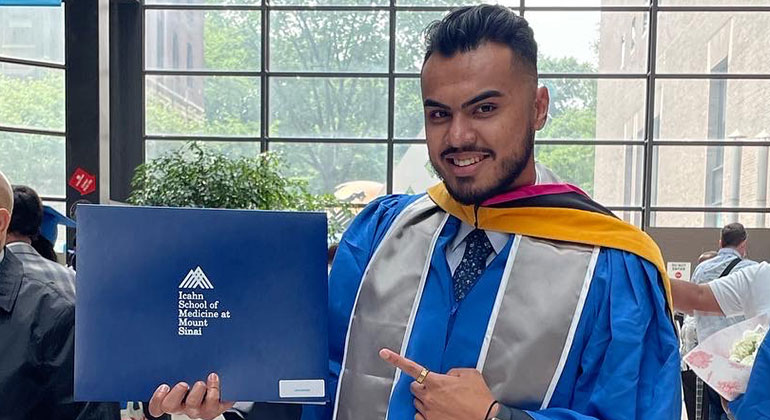
Young Patient Ends Years of Seizures With Treatment at Mount Sinai Epilepsy Program
One night in 2012, when Ravi was 14, he started twitching and jerking in his sleep. His mother, Rita, had worked in a surgical intensive care unit at Mount Sinai Hospital for 16 years, so she realized Ravi was having a seizure, though she didn’t know why. The family was living in India at the time.
Soon, Ravi began experiencing episodes three or four times a day. During a seizure he couldn’t speak or understand language and he would raise his hand in a gesture that meant, “don’t bother me!”. Then he started having bigger incidents every few months, with sudden stiffness that often made him fall down.
Ravi saw several doctors in India. “We had access to some of the best physicians in the country,” says Rita. A computed tomography scan showed Ravi had a small abnormality on the left side of his brain. But it wasn’t clear if that was causing the seizures. Rita became frustrated by the lack of diagnosis and reached out to the Mount Sinai Epilepsy Program.
The family took a trip to New York to meet with Lara Marcuse, MD, a neurologist and Co-Director of the Mount Sinai Epilepsy Program. Dr. Marcuse did magnetic resonance imaging and electroencephalography to see what was going on inside Ravi’s head. She confirmed the diagnosis of epilepsy, caused by a small tumor in Ravi’s left temporal lobe. This part of the brain controls language skills and remembering verbal information. Dr. Marcuse explained that Ravi had been experiencing frequent focal aware seizures (where the seizure affects a small part of the brain and the person is aware of their surroundings) and rare bigger seizures – focal to bilateral tonic-clonic (where the seizure spreads and the person loses consciousness and can stiffen and shake).
Dr. Marcuse treated Ravi long-distance for five years. She tried a series of medications, which controlled the bigger seizures - focal to bilateral tonic-clonic, but he continued to have the focal aware seizures. In 2015, the family moved back to the United States for closer access to The Mount Sinai Hospital. Ravi, at that point 17 years old, started college—despite still having several seizures a day. Dr. Marcuse broached the subject of surgery, but the family wasn’t ready yet.
In Ravi’s sophomore year of college, he felt his small focal aware seizure while driving and pulled the car over. He then had a larger seizure (his first in many years). This near accident prompted everyone to think more seriously about surgery. Ravi would need a craniotomy to remove the tumor. By this point, after much deliberation, Ravi was ready.
Saadi Ghatan, MD, did the surgery in the summer of Ravi’s junior year. Dr. Ghatan is a Professor of Neurosurgery and Pediatrics at Icahn Mount Sinai, Chair of Neurosurgery at Mount Sinai West and Mount Sinai Morningside, and Director of Mount Sinai’s Pediatric Neurosurgery Program.
“I had to be awake during my brain surgery and continue to answer questions to ensure my language and comprehension weren't affected,” Ravi says. “The whole surgical team made me feel comfortable and welcomed. Everyone was excellent.” The procedure was a success. “The Epilepsy Center at Mount Sinai doesn’t just excel in medical treatment but also takes extra steps to support patients emotionally and mentally,” says Ravi. The whole experience changed his life in more ways than one. Not only did it eliminate the seizures, it gave Ravi a calling: to become a physician.
Ravi maintains relationships with his doctors. “I am proud to say our patient-provider relationship has grown to friendship, and they all mentor me,” Ravi explains. He shadowed Dr. Marcuse and the epilepsy co-director, Madeline Fields, MD, Associate Professor of Neurology at Icahn Mount Sinai. “I was able to connect well with the patients I met while I was shadowing Dr. Marcuse and Dr. Fields because of my special understanding of both the patient and the doctor viewpoints.” Ravi was also a contributor to a research article written by Mount Sinai Epilepsy Program doctors, including Drs. Marcuse and Fields.
Ravi pursued a master’s degree in biomedical science from Icahn Mount Sinai and is now in the application process for medical school. “I want to share my story to raise epilepsy awareness and educate the public to end the stigmas associated with epilepsy.” Mother and son hope that by raising awareness, they will offer support, information, and access to people who need it.